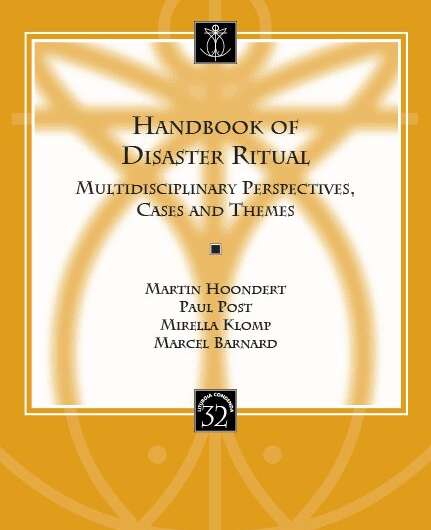Disaster rituals evolve from speeches and words to actions

Whether it's the tsunami in Japan, the MH17, Bali bombings, Breivik's massacre, or corona, rituals have been devised for disasters worldwide since time immemorial to commemorate the victims. Martin Hoondert, of the Tilburg School of Humanities and Digital Sciences, one of the compilers of the just-published "Handbook of Disaster Ritual," collected stories of rituals, their history and their function with a team of international scholars.
Emeritus Professor of Rituals Paul Post took the initiative for the book, which is a triptych with a multidisciplinary section, including case studies and analysis. "We boldly put it down as a handbook, because many administrators don't think about rituals, while people immediately ask for them after disasters and also start ritually marking the site of a disaster. The Handbook not only provides a framework for further research, but also for policy on rituals after disasters."
One of the most impressive rituals, in Hoondert's opinion, is that in Namibia, of the commemoration of the mass murder committed by the German colonists at the beginning of the last century. Germany apologized and offered compensation a few years ago. "It may seem strange to us, but the Herero walked a memorial march, donning brown uniforms of the German army. It's a reverse symbolism: that uniform is me. That was their way of dealing with the past. Another thing I appreciated was the art exhibition in Venice where a wreck of a rubber refugee boat was on display. Barca Nostra, our boat, it was called. Again, the symbolism was very strong, what do we really know about the crisis, about how people perish while fleeing? This boat made a whole journey from Africa, to Europe, to the Venice Biennale, becoming a collective monument."
What exactly do rituals do?
First of all, rituals have no use. You don't buy anything for them. But we also can't live without them. People can't bear to put loved ones in the ground just like that. Rituals are necessary to deal with grief, to make suffering and victims visible, to acknowledge them. And they also sometimes function as a request for help and a form of protest. When I look at the protests of young people at climate demonstrations, you see ritual acting against danger. Commemorations often include monuments, symbols of what people need to know, of staying informed, and not allowing to forget. The Holocaust museum, or monuments in Rwanda or Srebrenica, aim to remind us never to let these genocides happen again. Yet rituals are culture-specific. In Bali, for example, in 2002, during the commemoration of the bombings, there was no remembrance, but rather praise for the beauty and future of the island. Mentioning the disaster could evoke a new one.
You research funerals and now disasters and rituals, heavy topics all, with a lot of human, personal suffering, does that affect you personally?
My next research project is about divorces, not a happy subject either. But these are subjects that matter, they concern death, which of course occupies people. Furthermore, we are in the middle of so-called slow disasters, such as corona and global warming, subjects surrounding death that demand answers. If done properly, rituals can offer comfort and help, and if I can contribute to processing them, I am happy to do so. I am now supervising, together with a colleague, a Ph.D. project in Rwanda. I am amazed at how the hatred between the various population groups grew, but also how people got over it. Of course I am involved in what people are going through, for example the contacts in Sebrenica affect me enormously. I also realize that I live at a distance and that these people are right in the middle of it. I follow a Bosnian woman who made a play with a Dutchbatter, she was so brave, it may sound pathetic, but my heart goes out to those people. Of course that keeps me busy, you're involved, you can't help it.
And I like to translate my research into practice. They may be drops in the ocean, but I did research in Sebrenica on an exhibition about the massacre and was able to give advice to the board of this memorial site to take more account of the many schoolchildren who visit when setting up the exhibition. Sometimes it is enough for me to listen to these people. I interviewed a survivor, she thanked me, that I pay attention to this case so that it is not forgotten. So that applies not only to individuals but also to collective thinking; that a people is seen and heard.
How have rituals developed?
In the last 10 years, there has been a very clear shift from the ecclesiastical domain to the secular, although the latter still includes many religious elements, think of candle burning and processions that translate into silent marches. What strikes me is that rituals are becoming less linguistic, in fact the action aspect has increased. Less words and speeches, more action, marches, monuments at the locations involved so that a connection is made between past and present.
Provided by Tilburg University





















